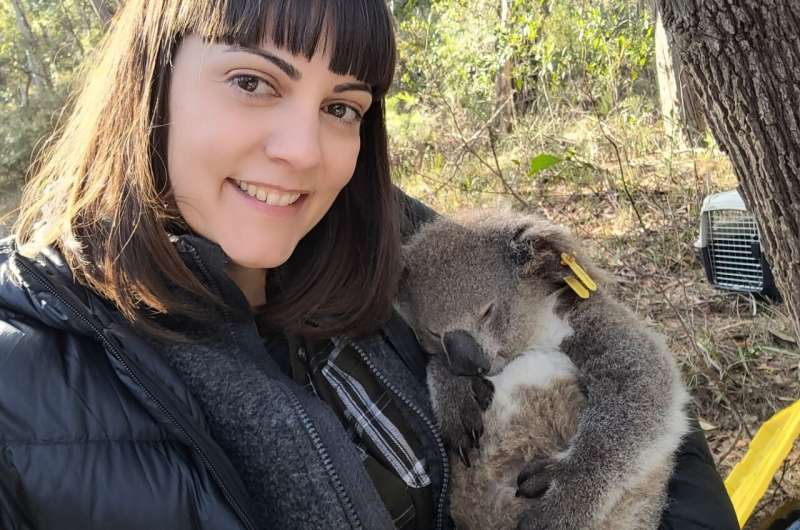This article has been reviewed according to Science X's editorial process and policies. Editors have highlighted the following attributes while ensuring the content's credibility:
fact-checked
trusted source
proofread
Koalas can predict and prepare for the hottest days of summer, study finds

The iconic marsupial can regulate its temperature to a greater degree than previously thought—but this could prove troublesome as global warming bites.
For the first time, free-ranging wild koalas have been observed regulating their body temperatures ahead of the hottest days of summer, by lowering their temperatures well below average during cooler morning conditions. The research has been published in Conservation Physiology.
Research lead Dr. Valentina Mella said, "This strongly suggests koalas predict the hottest days from morning conditions and adjust their core temperatures accordingly. We have never seen this type of behavior before in koalas."
Over two weeks in northwest New South Wales, scientists at the University of Sydney observed a colony of koalas during the hottest time of the year in 2019.
On the hottest day of the study (40.8 degrees Celsius), the scientists recorded the highest body temperature (also 40.8 degrees) ever measured in koalas.
However, on the same morning, the lowest ever recorded temperature for a koala was also measured (32.4 degrees), suggesting the endangered species regulates its body temperature to a greater degree than previously thought.
Dr. Mella, who is from the University of Sydney School of Veterinary Science, said, "This self-regulation requires individual koalas to predict days of extreme temperature from overnight and early morning conditions, adjusting their body heat regulation accordingly."
"Our results indicate that air temperature and koala body temperature are closely aligned. What surprised us was the self-regulating animals 'allowed' their core temperatures to fluctuate with environmental conditions, a possible adaptive tactic to reduce evaporative cooling, saving an estimated 18 percent of water," Dr. Mella said.
"It seems that this self-regulation of body temperature might play a more important role in surviving hotter days than known behavioral tactics, such as tree-hugging."
Koalas generally seek to maintain their core body temperature at 36.3 degrees within a range of 2.4 degrees.
"On hot days, it seems an adaptive form of heat regulation—starting with a lower body temperature—provides scope for letting body heat rise with air temperature rather than attempting to keep temperature strictly in the normal range using water and other techniques to cool down," Dr. Mella said.
"However, as temperatures increase due to climate change more generally, this survival technique could become quite risky. Temperatures above 40 degrees can be fatal for leaf-eating mammals, like koalas."
Koalas have physiological and behavioral methods to self-manage body temperature, including their highly insulative fur, ability to produce concentrated urine to conserve water and their low metabolism, which reduces heat production.
Further, koalas have also been observed panting and licking their fur to facilitate evaporative cooling. They also seek out cooler microhabitats and can adopt tree-hugging postures to promote heat exchange with cooler trees.
Earlier work by this research team also recorded koalas drinking freely available water during very hot days, behavior that was previously unknown.
"While we did observe tree-hugging on hot days, this did not seem to lower core body temperature markedly. While this could partly be due to the type of trees, this might not be a central strategy in body temperature modulation for this koala population," Dr. Mella said.
"The population of koalas we observed, near Gunnedah in NSW, is older and, like many koala colonies, suffers from chlamydial disease," Dr. Mella said.
The researchers highlight that all the koalas observed in the study were alive six months later, a sign that the higher-than-expected modulation of body temperature is a survival technique for the species.
Dr. Mella said, "Global climate models forecast that dry, hot weather will escalate and drought events will increase in frequency, duration and severity. This is likely to push koalas and other tree-dwelling leaf-eating mammals towards their thermal limit.
"Our results reinforce the importance of climate mitigations for ensuring future survival of koalas," she said.
More information: Valentina S A Mella et al, Hot climate, hot koalas: the role of weather, behaviour and disease on thermoregulation, Conservation Physiology (2024). DOI: 10.1093/conphys/coae032
Provided by University of Sydney



















